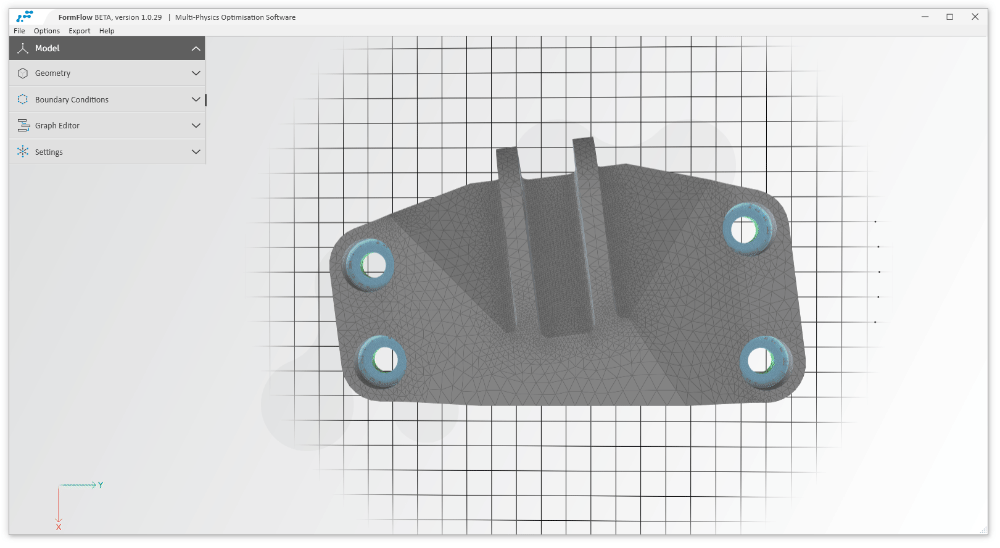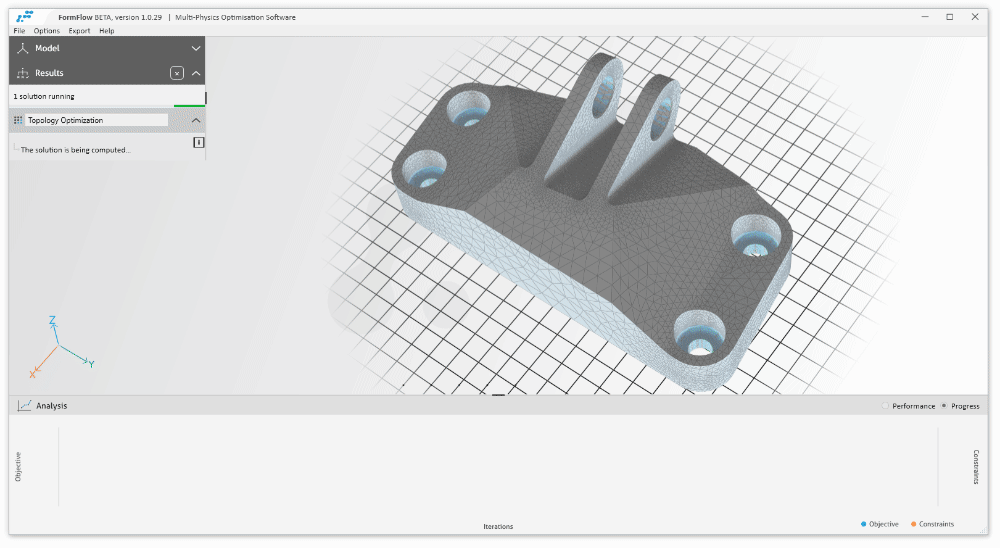Additive Flow Launches Formflow
LONDON, UK: Additive Flow releases Formflow – Multi Property Optimisation now here.
Additive Flow’s product launch of Formflow is well received, opens new frontiers for users to deliver 50%+ cost savings, exceed sustainability goals, and meet the demands of innovators and manufacturers.
Additive Flow; a leading developer of advanced optimisation software, recently named amongst ‘Top 10 London advanced digital technology innovators’ by Digital Catapult on behalf of Mayor of London, has successfully delivered their beta program with leading organisations such as Manufacturing Technology Centre, and have launched the anticipated first release of its ‘Formflow’ optimisation software with key patterns and customers.
With materials and manufacturing advancements enabling the production of multi-functional parts coupled to varying properties based on local engineering requirements, Formflow is able to manage these properties throughout the digital workflow.
Additive Flow pairs multi-physics with multi-objective algorithms and material science to deliver manufacturable solutions. Formflow software balances performance and cost saving – with achieving and maintaining required material properties in their proper place.
Additive Flow’s software has a number of standout features:
- Accessible interface for powerful multi objective optimisation, empowering users to switch optimisation goals and constraints
- Algorithms that allocate multiple material properties (via lattices, build-parameters, and materials) simultaneously with topology
- Multi-physics capability tightly coupled with as-printed material properties
As our beta programme organisation, The Manufacturing Technology Centre (MTC) puts it:
“The multi-material property optimisation gives us new potential capability to explore for applications meeting competing objectives. The software has more metrics than we are used to seeing, and has the ability to combine them in an accessible way. It can lower the barrier to working with multi-objective optimisations, opening industry to new arenas.
We have enjoyed being part of Additive Flow’s beta programme. We look forward to continuing to work with the team at Additive Flow, to explore the promising capabilities of their software and we will continue to investigate these as they come online.”
Andrew Triantaphyllou, Technology Manager, Design for Additive Manufacturing (DfAM) at the MTC
Tradeoffs between different objectives have long been a challenge of engineers and commercial decision makers – how to meet competing objectives and constraints within teams and business units? Impossible tradeoffs between sustainability and costs, or product performance and manufacturing lead times – often create headaches and challenges in organisations large and small, as engineers have to address competing goals.
This leads to many iterations, revisions, and redesigns based on the different choices of inputs (safety factors, materials, geometry constraints) and their implications on shapes, procurement, and profitability – which bounce back and forth between teams – increasing costs, while limiting innovation. Amid this complexity, considerations such as environmental impact can be missed.
Alexander Pluke, CEO of Additive Flow says, “The engineers and businesses we’ve spoken with want to do better when it comes to harnessing innovation and sustainability, but are too often caught between their time limits, cost considerations and performance needs. Engineers have been calling out for a tool that can help them address these challenges, and we have had great feedback from our users on the new frontiers now available to them with Formflow’s capability”.
At the same time, workflows to simulate and optimise designs, production, and supply chains have been locked down by software vendors (with predefined ‘one size fits all’ settings), which rarely meet the actual requirements of the business.
This is solved by Additive Flow, which enables users to create repeatable Optimisation workflows can be easily edited, retained, and shared amongst teams – for maximum productivity, automation, and enhancing your digital thread – and specify the exact requirements you are looking for on local regions of engineering parts, while optimising for specific business needs like cost and sustainability.

An example of the impact Additive Flow’s software has had on businesses beyond Additive Manufacturing is Comeragh Composites:
“The analysis carried out with Additive Flow’s software helped reduce manufacturing costs by 50% and saved weight by 60%, by simplifying the injection moulding process and enhancing our ROI with multi- property composites.
Of even greater interest was that the process opened my eyes to what is feasible – on larger and more complex components with potentially even more significant advantages using Additive Flow’s software. You can simplify your supply chain by adopting a new approach to material use and selection.”
Findhan Strain, Director, Comeragh Composites
New frontiers
Additive Flow’s proprietary algorithms optimise multi-functional parts (i.e. thermal, frequency, structural) by integrating multiple physics within a coupled optimisation loop. This allows the allocation of material properties that address the specific local needs of a part.
Additive Flow’s multi-property optimisations enable tailored material properties to meet competing functions within a part, based on allocating multiple lattices, build parameters, or materials – in conjunction with topology – depending on the technology and material requirements. This enables new possibilities for optimisation that have delivered cost savings of 50%+, and accelerated development iterations from months to days.
“With our holistic process chain, we are extensively working on the qualification of new metal alloys for LPBF processes.
With the multi-physics simulation models and repeatable optimisation workflows from Additive Flow, the full potential of AM processes could be released by functionally graded materials and components.”
Gregor Graf, Head of Engineering at Rosswag
These capabilities have been applied across many industries, with Additive Flow having recently delivered a corner-stone project with Saint-Gobain for thermal optimisation, in high performance ceramic applications for hybrid additive manufacturing.
“In Saint-Gobain, our focus is on making the world a better home. For many of our businesses, we look to specialty materials to solve every day challenges.
Additive Flow enabled us to consider multi-material scenarios and quickly iterate designs and proposals for our customers.
We were able to show how our customers’ cost and sustainability objectives could be met with optimised part design and manufacture.
We have enjoyed working with Additive Flow, taking one step beyond additive manufacturing into ceramic processing, and are excited that Additive Flow’s software is now available. We can see many applications to improve workflows across industry and look forward.”
Neha Burke, General Manager Surface Conditioning, Saint-Gobain Ceramics

Projects are also underway with 3DGBIRE and other international supply chain partners that span automotive, aerospace and industrial processing components.
“At 3DGBIRE we’re always striving to remove barriers for industry to adopt additive manufacturing so partnering with Additive Flow fits perfectly. The consultative, applications focused approach of both companies with the combined ‘know how’ will ensure many organisations can approach AM with confidence and save huge amounts of time and cost. Exciting times ahead!”
Paul Croft, Director, 3DGBIRE
High Performance
Charles Fried, CTO at Additive Flow explains the importance of our in-house development “We have built our solvers from the ground up to be both highly computationally efficient and achieve the demanding goals of our customers. This means compelling performance and robust accuracy against benchmark results”
Naveed R. Parvez, CEO of Andiamo explains the impact this has had on their team:
“Healthcare globally is in need of radical solutions to meet mounting pressures. We need everyone to focus on the outcome and not the process. This is a philosophy we share with Additive Flow and proved to be instrumental during a large multi year NHS project. Clinicians told us that they were often trying to avoid a condition getting worse.
With Additive Flow we could now optimise for improvement whilst still meeting all the clinical and engineering requirements. With Additive Flow we saw processing speed improvements of up to 5x which allowed us to increase our productivity by at least 30% per engineer – ultimately allowing us to treat more people more quickly. “
Naveed R. Parvez, CEO of Andiamo
Alexander Pluke concludes, “‘We recognize the impact our software can have on businesses’ KPIs such as cost saving and time to market, but what really drives Additive Flow as an organisation is empowering our users to achieve what they want.
As one of our early users told us “Using your software is like being a kid in a candy shop, where I can explore all the new things that I have previously not been able to do”. ’